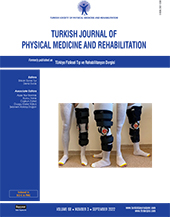COVID-19, cardiac involvement and cardiac rehabilitation: Insights from a rehabilitation perspective - State of the Art
2 Department of Physical Medicine and Rehabilitation, TOBB University of Economics and Technology School of Medicine, Ankara, Türkiye
3 Department of Physical Medicine and Rehabilitation, University of Health Sciences, Ankara City Health Training and Research Hospital, Ankara, Türkiye
4 Department of Physical Medicine and Rehabilitation, Koç University School of Medicine, Istanbul, Türkiye
5 Department of Physical Medicine and Rehabilitation, Trakya University Faculty of Medicine, Edirne, Türkiye
6 University of Health Sciences, Istanbul Physical Medicine and Rehabilitation Training and Research Hospital, Istanbul, Türkiye
7 Department of Physical Medicine and Rehabilitation, Manisa Celal Bayar University Faculty of Medicine, Manisa, Türkiye
8 Turkish Ministry of Health, Erenköy Physical Therapy and Rehabilitation Hospital, Istanbul, Türkiye
9 Department of Physical Therapy and Rehabilitation, University of Health Sciences, Kayseri City Health Training and Research Hospital, Kayseri, Türkiye DOI : 10.5606/tftrd.2022.11435 Since the beginning of the pandemic, many novel coronavirus disease 2019 (COVID-19) patients have experienced multisystem involvement or become critically ill and treated in intensive care units, and even died. Among these systemic effects, cardiac involvement may have very important consequences for the patient`s prognosis and later life. Patients with COVID-19 may develop cardiac complications such as heart failure, myocarditis, pericarditis, vasculitis, acute coronary syndrome, and cardiac arrhythmias or trigger an accompanying cardiac disease. The ratio of COVID-19 cardiac involvement ranges between 7 and 28% in hospitalized patients with worse outcomes, longer stay in the intensive care unit, and a higher risk of death. Furthermore, deconditioning due to immobility and muscle involvement can be seen in post-COVID-19 patients and significant physical, cognitive and psychosocial impairments may be observed in some cases. Considering that the definition of health is `a state of complete physical, mental and social well-being`, individuals with heart involvement due to COVID-19 should be rehabilitated by evaluating all these aspects of the disease effect. In the light of the rehabilitation perspective and given the increasing number of patients with cardiac manifestations of COVID-19, in this review, we discuss the rehabilitation principles in this group of patients. Keywords : Cardiac disease, cardiac rehabilitation, cardiovascular, COVID-19, SARS-CoV-2


















